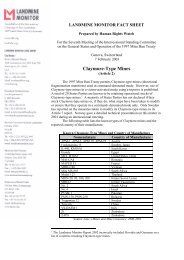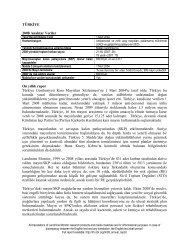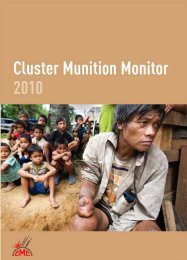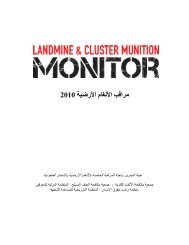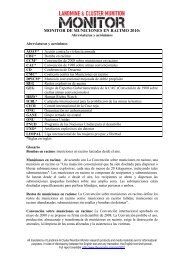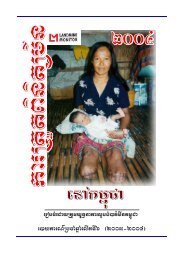Download PDF - Landmine and Cluster Munition Monitor
Download PDF - Landmine and Cluster Munition Monitor
Download PDF - Landmine and Cluster Munition Monitor
You also want an ePaper? Increase the reach of your titles
YUMPU automatically turns print PDFs into web optimized ePapers that Google loves.
© IKV Pax Christi, June 2012<br />
Preface<br />
<strong>Cluster</strong> <strong>Munition</strong>s<br />
<strong>Cluster</strong> munitions pose significant dangers to civilians for two principal reasons: their impact at the time of use <strong>and</strong> their<br />
deadly legacy. Launched from the ground or dropped from the air, cluster munitions or bombs consist of containers that<br />
open <strong>and</strong> disperse submunitions indiscriminately over a wide area, claiming both civilian <strong>and</strong> military victims. Many<br />
explosive submunitions or bomblets fail to detonate as designed when they are dispersed, becoming de facto l<strong>and</strong>mines<br />
that kill <strong>and</strong> maim indiscriminately long after the conflict has ended, <strong>and</strong> create barriers to socio-economic development.<br />
To protect civilians from the effects of cluster munitions, Norway <strong>and</strong> other like-minded countries initiated a fasttrack<br />
diplomatic process in 2007 aimed at creating a new international treaty. Working in partnership with UN agencies,<br />
the International Committee of the Red Cross (ICRC), <strong>and</strong> civil society grouped under the <strong>Cluster</strong> <strong>Munition</strong> Coalition<br />
(CMC), the Oslo Process resulted in the adoption in May 2008 of the Convention on <strong>Cluster</strong> <strong>Munition</strong>s.<br />
After 30 states ratified, the Convention on <strong>Cluster</strong> <strong>Munition</strong>s entered into force on 1 August 2010. It prohibits the use,<br />
production, transfer, <strong>and</strong> stockpiling of cluster munitions. The convention also requires destruction of stockpiled cluster<br />
munitions within eight years, clearance of cluster munition remnants within 10 years, <strong>and</strong> assistance to victims, including<br />
those killed or injured by submunitions as well as their families <strong>and</strong> affected communities.<br />
<strong>Cluster</strong> <strong>Munition</strong> Coalition<br />
Launched by non-governmental organizations in November 2003, the <strong>Cluster</strong> <strong>Munition</strong> Coalition plays a crucial<br />
facilitating role in leading global civil society action in favor of the ban on cluster munitions. With campaign contacts<br />
in more than 100 countries, the <strong>Cluster</strong> <strong>Munition</strong> Coalition works for full universalization <strong>and</strong> implementation of the<br />
Convention on <strong>Cluster</strong> <strong>Munition</strong>s. In January 2011, the CMC merged with the International Campaign to Ban <strong>L<strong>and</strong>mine</strong>s<br />
(ICBL) to become the ICBL-CMC, but the CMC <strong>and</strong> ICBL remain two distinct <strong>and</strong> strong campaigns with dedicated<br />
staff.<br />
Members<br />
of IKV Pax<br />
Christi h<strong>and</strong><br />
over copies<br />
of the 2012<br />
“Worldwide<br />
investments<br />
in cluster<br />
munitions:<br />
a shared<br />
responsibility”<br />
report to<br />
German<br />
members of<br />
parliament.<br />
<strong>L<strong>and</strong>mine</strong> <strong>and</strong> <strong>Cluster</strong> Monition <strong>Monitor</strong><br />
<strong>L<strong>and</strong>mine</strong> <strong>and</strong> <strong>Cluster</strong> <strong>Munition</strong> <strong>Monitor</strong> (the <strong>Monitor</strong>) provides research <strong>and</strong> monitoring for both the CMC <strong>and</strong> the ICBL<br />
on the Convention on <strong>Cluster</strong> <strong>Munition</strong>s <strong>and</strong> Mine Ban Treaty respectively. Created by the ICBL as <strong>L<strong>and</strong>mine</strong> <strong>Monitor</strong><br />
in June 1998, the initiative became the research <strong>and</strong> monitoring arm of the CMC in 2008 <strong>and</strong> changed its name in 2010<br />
to <strong>L<strong>and</strong>mine</strong> <strong>and</strong> <strong>Cluster</strong> <strong>Munition</strong> <strong>Monitor</strong>, known simply as “the <strong>Monitor</strong>.”<br />
The <strong>Monitor</strong> represents the first time that NGOs have come together in a coordinated, systematic, <strong>and</strong> sustained<br />
way to monitor humanitarian disarmament treaties, <strong>and</strong> to regularly document progress <strong>and</strong> problems. Established in<br />
recognition of the need for independent reporting <strong>and</strong> evaluation, the <strong>Monitor</strong> has put into practice the concept of civil<br />
society-based verification. It has become the de facto monitoring regime for both treaties, monitoring <strong>and</strong> reporting on<br />
States Parties’ implementation <strong>and</strong> compliance, <strong>and</strong> more generally, assessing the international community’s response<br />
to the humanitarian problems caused by l<strong>and</strong>mines, cluster munitions, <strong>and</strong> other explosive remnants of war (ERW). The<br />
<strong>Monitor</strong>’s reporting complements transparency reporting by states required under the treaties <strong>and</strong> reflects the shared view<br />
that transparency, trust, <strong>and</strong> mutual collaboration are crucial elements for the successful eradication of antipersonnel<br />
mines <strong>and</strong> cluster munitions.<br />
The <strong>Monitor</strong> is not a technical verification system or a formal inspection regime. It is an attempt by civil society to hold<br />
governments accountable for the legal obligations they have accepted with respect to antipersonnel mines <strong>and</strong> cluster<br />
munitions. This is done through extensive collection <strong>and</strong> analysis of publicly available information, including via field<br />
missions in some instances. The <strong>Monitor</strong> works in good faith to provide factual information about issues it is monitoring,<br />
in order to benefit the international community as a whole. It aims to promote <strong>and</strong> advance discussion in support of the<br />
goal of a world free of l<strong>and</strong>mines <strong>and</strong> cluster munitions.<br />
iii



